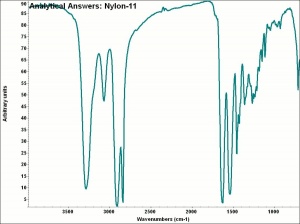Nylon 11
Description
Nylon 11 is composed of polymerized 11-amino-undecanoic acid. Nylon 11 was originally made from oil castor bean oil and marketed under the trademark of Rilsan. Nylon 11 fibers have similar properties to nylon 6 and 6,6. Nylon 11, however is less dense, melts at a lower temperature and has better dimensional stability. It is often used for brush bristles, lingerie, bulked yarns, and injection molded plastics.
See also fiber nylon fiber.
Synonyms and Related Terms
PA11; polyamide 11; polyundecanamide; Nylon [Du Pont]; Rilsan [Arkema]; Rilsanite
Other Properties
Resistant to alkalis and most organic solvents. Degraded by concentrated acids and phenol. Burns with yellow-orange flame and blue smoke; smells of burnt horn. Fiber is smooth. Cross section is circular. Tenacity = 5.0-7.5 g/denier (dry or wet); Elongation = 25% (dry or wet); Moisture regain = 1.18%
| Melting Point | 189 |
|---|---|
| Density | 1.04 |
Additional Information
G.Cook, Handbook of Textile Fibres:II. Man-made Fibres, 5th edition, Merrow Publishing Co., Durham, England, 1984.
Authority
- G.S.Brady, G.S.Brady, Materials Handbook, McGraw-Hill Book Co., New York, 1971 Comment: p. 553
- Richard S. Lewis, Richard S. Lewis, Hawley's Condensed Chemical Dictionary, Van Nostrand Reinhold, New York, 10th ed., 1993
- Marjory L. Joseph, Marjory L. Joseph, Introductory Textile Science, Holt, Rinehart and Winston, Fort Worth, TX, 1986
- J.Gordon Cook, J.Gordon Cook, Handbook of Textile Fibres:II Man-made Fibres, Merrow Publishing Co. , Durham, England
- Website address 1, Website address 1 Comment: www.astm.org
- F. Kidd, F. Kidd, Brushmaking Materials, Bristish Brush Manufacturers, London, 1957
